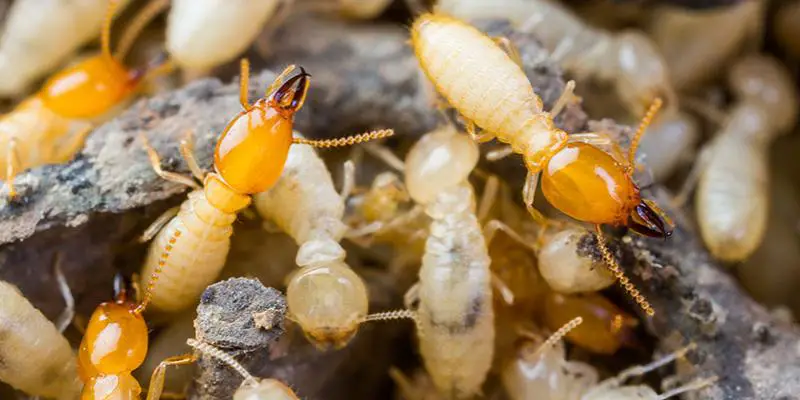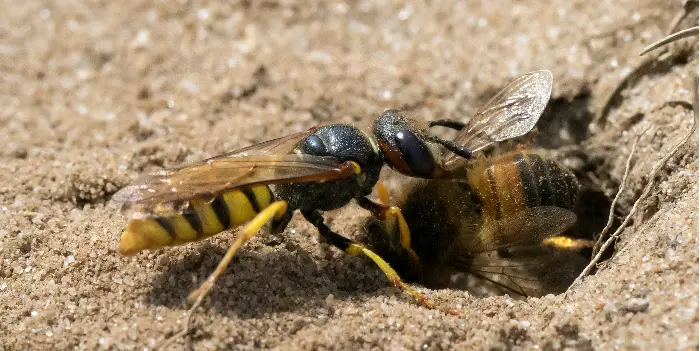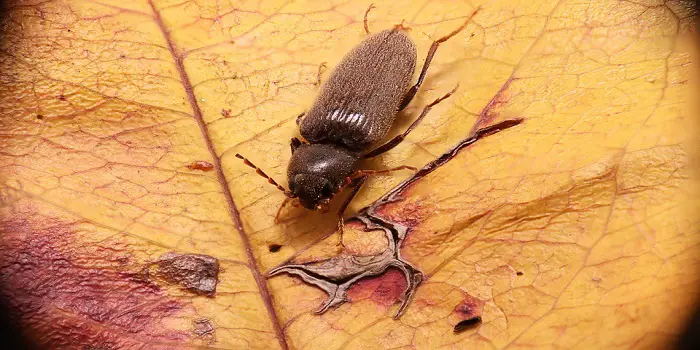
Woodworm is a problem that can seriously impact homes and furniture.
Without proper care, the problem of woodworm will only get worse.
Fortunately, there are a few things that you can do to solve the issue, especially with antique furniture and small infected areas.
By knowing the proper techniques, what woodworm are, and how to identify them, you can be perfectly prepared to deal with the issue and get your home back to the best condition possible.
What are Woodworms?
Woodworms are wood-boring beetles that burrow into and eat wood.
They are small insects from the family Anobiidae and are formed from the larvae.
In general, the life cycle of woodworms is divided into 4 phases: eggs, larvae, pupa, and adults.
Surprisingly, the larval stage is responsible for the most damage to the wood from the inside.
Woodworm larvae are usually creamy white color insects with curved bodies.
When reaching their adult stage, they develop wings and will move to a new location for mating and reproducing.
There are many different kinds of woodworm.
Different types of woodworm that may occur in different parts of the world include:
- Common Furniture Beetle
- House Longhorn Beetle
- Death Watch Beetle
- Wood-Boring Weevil
- Bark Borer Woodworm
- False Powder-Post Beetle
Each of them can be distinguished by the type of soft or hardwood they like attacking in different areas.
Most of them also enjoy damp or arid areas, which is one of the things that can attract them.
Signs of Woodworm
Woodworms are small and can quickly grow, which, coupled with their tendency to cause damage, can be a terrible combination for your furniture.
Woodworm burrows into the wood, and a sign of their presence, besides dead beetles and larvae, are little holes extending into wooden surfaces, whether furniture or accents or beams or supports.
Sometimes you may also notice some dust around the holes, which can signify the first infestation.
This is not the dust as you may have felt, but it’s the droppings of the larvae that may look like fine sawdust.
The third sign that will help you know whether you have woodworm is the sound they make while biting and feeding on wood.
Most likely, you will hear the odd noise that comes from the inside of wood furniture.
With these things in mind, it is clear that woodworms are not good to have in the home, especially if you have antique furniture lying in your living room.
Also, keep in mind that prolonged access to wood can cause even more damage than typical.
So, it’s important that if any of these signs are seen, the proper next steps should be taken.
Before we get into the tips for getting rid of them, let us check why woodworms are attracted to your furniture in the first place.
Why Are They in Your Furniture?
As I mentioned, woodworm attracts overly damp or dry areas.
In rooms without proper ventilation, the beetles will be drawn to furniture to burrow.
Especially in rooms that are conducive to woodworm, older furniture can be easily targeted.
With that said, older antiques (with wood that is more brittle) are easier for these woodworms to dig into.
In addition, pieces of furniture that use thinner bits of wood are more likely to get infected by woodworms.
And, though it is not often discussed, if one item of furniture is close to another that had been infected with woodworm, it is likely to also be attacked.
When all of these things are combined, woodworm is likely, so it is best to regularly check to make sure such things are not happening.
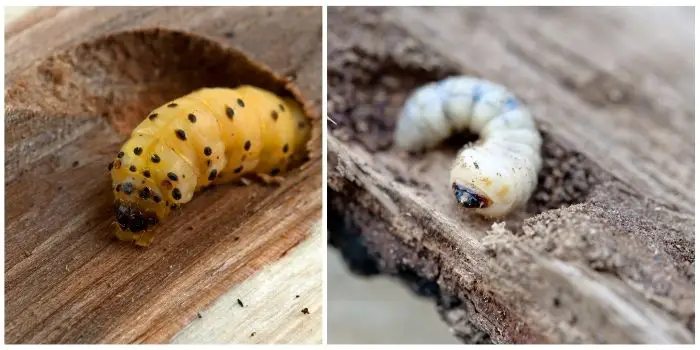
How to Treat Woodworm in Antique Furniture?
When it is clear that there are woodworms in the home, there are a few things that you can do.
However, when attempting to get rid of woodworm, you should do your best to ensure that the wood does not get damaged.
Tips for Fixing the Small Infected Area
When only a small number of beetles are confined to a small area, such as furniture and sections of woodwork, you can easily remove and refinish the area.
Applying the needed materials to pure wood is the best way to make sure woodworms are affected and removed.
That means that all wood infected by woodworm must be stripped of stain, epoxy, and any other things that may be coating the wood.
Once that is completed, insecticide and wood-safe chemicals like Borax can be applied carefully to the areas of the wood that are being harmed by the woodworms.
Once that has been completed, there is also the option to apply wood putty to the infected area.
This can help make wood look like it has not been damaged.
Then top coats (like primer, paint, stain, and varnishes) for the wood can be reapplied and secured, though this should first be done after the insecticide has been allowed to work.
This allows for the best possible final result for wooden surfaces that have been hosting woodworm.
These steps are relatively simple to perform, which means you can quickly fix the minor damages to your furniture and contained areas from woodworms if the infected area is small.
Tips for Fixing the Large Infested Wood Surfaces
Beyond the simple situations, homeowners are not as good at getting rid of woodworm as trained professionals are, for they have the needed equipment and proper training for the job.
For example, in situations where woodworm has infected wood so much that it is at risk of falling apart, homeowners should leave the work to other people.
With that said, if beams or supports become brittle or are so infested that they become likely to be so, you are not capable of taking care of the issue alone.
Instead, professional companies should be hired to take care of the problem.
They may suggest replacing parts of the home or furniture too damaged to be repaired.
They are also very capable of handling a wide variety of scenarios.
Removing old vintage furniture and replacing them with newer items is a last resort.
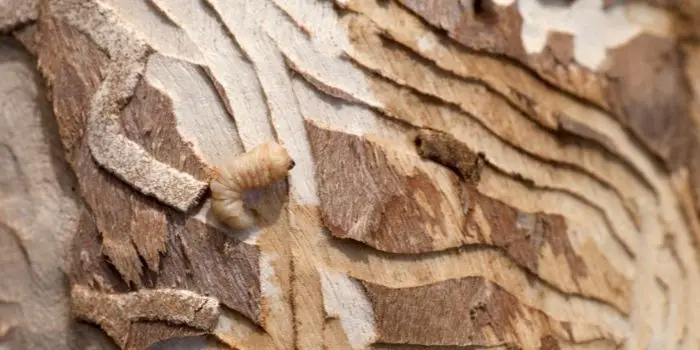
Home Remedies to Remove Woodworm from Wood
Woodworms, when present inside the wood, can be difficult to see through naked eyes because of their small size.
Only when they come out and create holes can we judge the infestation.
Using natural repellents and home remedies against woodworms is an excellent option to protect your expensive furniture at home.
Some of the most effective home remedies to kill woodworm are as follows…
1- White vinegar
Vinegar serves as an excellent natural remedy that can help in eliminating many kinds of insects from your home.
Take white vinegar or a mixture of vinegar and lemon juice in a sprayer.
Spray it on all the wooden surfaces you suspect are infested by woodworms.
Using this technique, you can also prevent woodworms from approaching.
2- Fresh acorns
Woodworms like the smell of fresh acorns. So, you can use them to attract these insects.
Wrap a few fresh acorns in a cloth and place them near the wooden surfaces.
Woodworms will most likely lay their eggs on this cloth/bag during the breeding season.
Larvae will then enter the acorns for feeding, and this is the time when you can remove these bags.
The overall process is slow but can be effective in keeping away the damaging woodworms from your furniture.
3- Mint and lemon
Preparing an infusion of mint plant and lemon juice and then spraying it on the wood surfaces is another good remedy for keeping your furniture protected.
- Simply take some mint and lemon juice in a container
- Infuse it on fire for about 15-20 minutes
- Allow the mixture to cool down and then use it to control the insects
4- Boric acid, ginger, and water
Prepare a mixture of boric acid, ginger, and water.
Brush it over the wood surface or put it inside the wood holes/cracks where you suspect that the larvae are feeding on the wood cellulose.
When consuming this treated wood, cellulose larvae will die soon.
5- Lavender, clove, rosemary, and other essential oils
Essential oils like rosemary, lavender, clove, eucalyptus, basil, etc., mixed in water, serve as a good natural repellent spray for woodworms and many other insects.
You can simply inject this mixture into the interior of the wood through the visible holes.
Repeat the process for a few days to get better results.
Since the aroma of these essential oils is very unpleasant for woodworms, they will simply move away from your furniture.
Besides the above remedies, baking soda, bleach, WD-40, kerosene, paint stripper, lacquer thinner, Varsol, and brake cleaner are other few products that can act as a good repellent against woodworms.
If you want, try a combination of these methods so that these pesky insects do not come to your home.

How to Prevent Woodworm in Your Wooden Furniture?
While on the subject of woodworm, however, everyone should also know how to prevent them.
First of all, proper airflow is part of successfully keeping woodworms away from your furniture and other wood items at home.
Plus, you should also make sure that the spaces are not too dry and, subsequently, not too wet, which is one of the greatest ways to stop woodworm from entering your home.
In addition to correctly ventilating spaces, you should treat the home areas as soon as the woodworm is spotted.
This means that if an old chair becomes infected with a woodworm, every wooden object around it should be treated with insecticides and other materials.
Many objects in your home are susceptible to woodworm, and this technique should be applied if any become infested.
Also, regular checking and examining should be completed to ensure that there is no new woodworm and that all items of furniture and all accessories are free of beetles.
By doing these things, you can reduce the risk of woodworm exponentially and lessen their anxiety for future infestations.
Other Related Questions:
Can wood beetles bite?
Many people do believe that woodworms bite.
But the truth is they won’t bite or sting you because they are beetles that are considered to be harmless insects.
With that said, they do have a type of parasite-host that can attack humans and can prove to be dangerous.
What temperature kills woodworm?
The larvae of the woodworm cannot survive high and very low temperatures.
To keep your small furniture pieces free from woodworms you can therefore keep them in an oven, on a radiator, or in a room with a space heater.
When heating, try to keep the temperatures to about 140 degrees F for 24 hours which will kill eggs, as well as larvae.
For cooling, you can use the industrial refrigerator. Placing the affected pieces at subzero temperatures for at least 24 hours will help kill the insects.
Should you buy a house with woodworm?
Buying furniture or a house with a woodworm infestation is not a good idea.
Severe woodworm damage will not only cause your roof to lose its structural integrity but also the foundation to begin to sink lower with passing time.
Before buying, it’s good to understand the level of infestation and the treatment costs involved.
The Conclusion
Woodworm is an issue that can affect many homes and large wooden buildings if not adequately guarded against.
They are usually caused by beetles that burrow into wood, attracted by dry or damp conditions in homes.
Keep in mind that woodworm can damage more than just the old furniture in your home without the correct care.
Hopefully, by following the above tips to prevent and fix the problems presented by woodworm, your antiques can be safeguarded for the future.
Share the post "How to Treat Woodworm in Antique Furniture Naturally?"

Welcome to ProShieldPest.com. I am Tina Jones. I have been working as a pest removal professional in Winslow, Arizona lately. At present, I love to spend my time with my family as a retiree.
Here I share all my knowledge and experiences to help people understand better how they can stop pests at their homes without actually killing them. Hopefully, the information you will find here will help in safeguarding your home! You can check more about me here.

